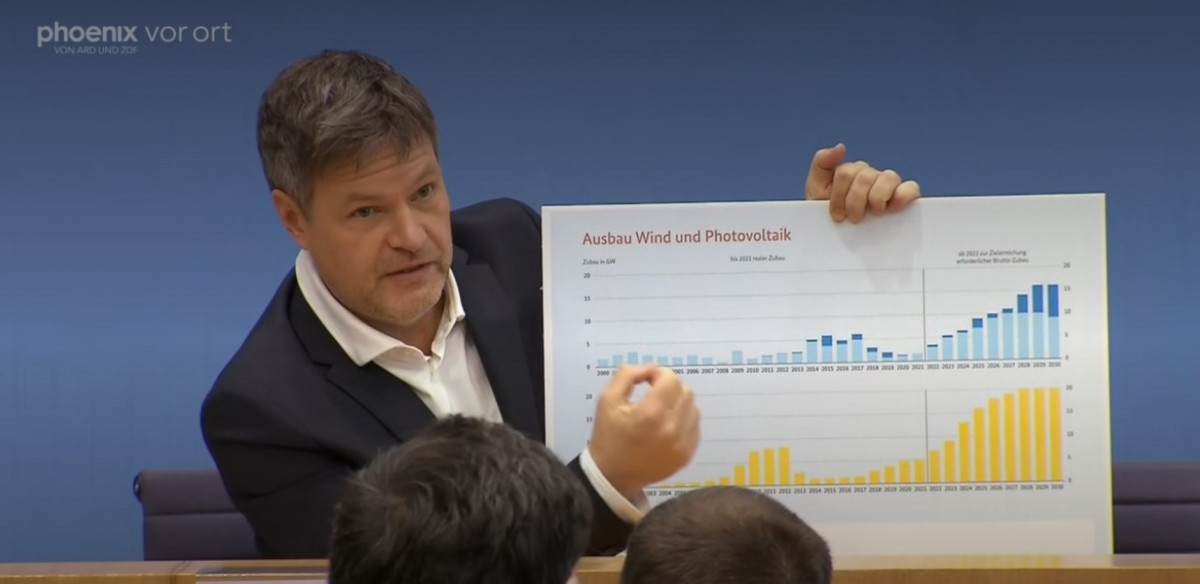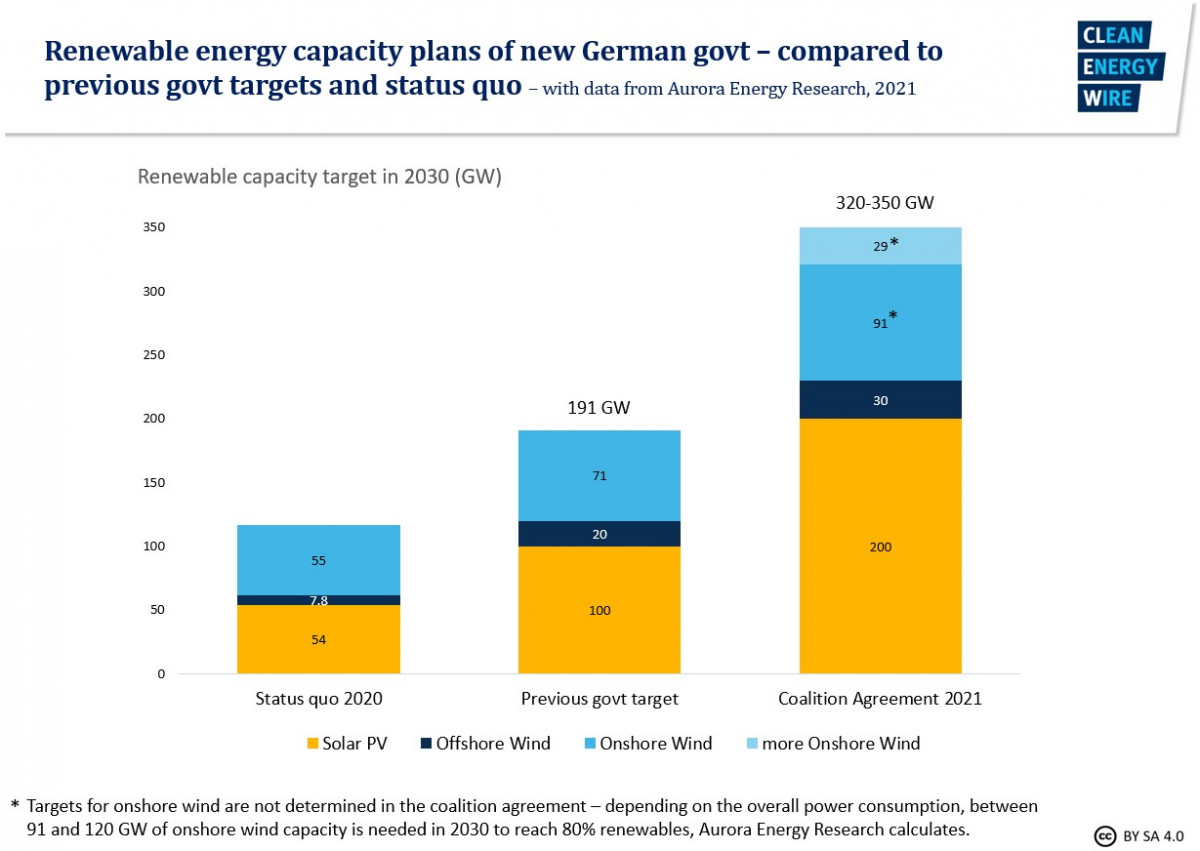Germany to launch emergency programme for “huge, gigantic” 2030 emissions target task
Germany’s new government plans to initiate a massive renewables boost to tackle the “huge, gigantic” task of decarbonising industry, mobility, and heating to reach greenhouse gas reduction targets at the end of the decade, economy and climate minister Robert Habeck announced in Berlin.
As it stands, Germany is failing its emission reduction goals in 2021 and 2022 and is headed for a 15 percent target miss in 2030 if no new measures are deployed, Habeck (Green Party) said during a first stock take and presentation of future policy measures.
Germany needed to triple its emission reductions to make good on the “drastic backlog”, he said. “We have eight years to achieve the same growth in the share of renewables that we have achieved in the past 30 years,” Habeck said, referring to the share of renewable energies in power consumption which has grown to over 40 percent since 1990 and has to make up 80 percent by 2030. Habeck’s ministry expects power demand to rise from about 560 terrawatt-hours (TWh) currently to around 700 TWh by 2030, whereas the previous government had calculated a demand of roughly 660 TWh.
“It is a major political task. But one that presents an enormous opportunity for the country,“ Habeck said, conceding that the necessary changes would “deeply affect social reality”.
Onshore wind at the heart of a new renewables boom
Making more onshore wind capacity additions possible is at the heart of the government’s climate action emergency programme. With a reform of the Renewable Energy Act (EEG), the volume of renewable power auctions will be increased. In the short term, a change in distance rules from radio beacons and military areas could free up some 9 gigawatts (GW) of land where wind turbines have otherwise been approved, Habeck said. By making renewables expansion an “overriding public interest”, it can take priority over other concerns, such as nature conservation and animal protection. Finding the right balance between nature conservation and renewable energies is the crucial task at the moment, Habeck said. Changing the consideration hierarchy in favour of renewables would also help with the expansion of Germany's power grid infrastructure, he said.
To ensure that the necessary two percent of Germany’s land area are designated to wind energy, Habeck plans to tour the federal states by summer and find support for his new “Onshore Wind Act”. So far only two states – Hesse and Schleswig-Holstein – are close to reaching the two percent target. While not every state would have to reach the two percent mark itself - deals between neighbouring states to ensure the overall necessary amount would be possible, - wind planning preventing rules that, for example, insist on extra long distances between wind turbines and houses (10H rule), would have to go, Habeck said.
A reaction to this from Bavaria, where such distance rules have thwarted wind power expansion in the past years, came promptly: "The 10H rule will not be changed. The Bavarian regulation on wind power ensures acceptance and public participation. Robert Habeck should be more concerned with the necessary construction of power lines and the prevention of gaps in supply," Markus Blume, general secretary of the conservative CSU party in Bavaria wrote on twitter.
Wind energy association BWE said that an expansion of onshore wind is needed in all federal states. "Especially the high-consumption south-east and south-west must catch up very quickly," said BWE president Hermann Albers.
Making solar PV mandatory on commercial buildings and the rule on new private buildings, increasing tender thresholds, and making more space for ground-mounted solar installations are the other part of the plan to grow Germany’s two most important renewables power sources.
The energy and climate ministry (BMWi) plans to bundle these measures in an “Easter package” to be ready for cabinet approval at the end of April, followed by a second “summer package”. Parliament decisions and, if necessary, EU approval would then happen in the second half of the year with the aim of having all new measures up and running as of 2023.
Contracts for difference for industry and much more hydrogen
Also high on the list of the new minister is creating the legal and financial frameworks for carbon contracts for difference, an instrument that supports industry in transitioning to climate-neutral production processes, as well as the scaling of hydrogen resources. “For the annual consumption of the steel industry alone, we need 15 TWh of hydrogen in 2030,” Habeck said, adding that such figures would demand doubling the production plans of the national hydrogen strategy.
The German chemical industry welcomed this announcement, saying that, without carbon contracts for difference, there will be no investment in transformative technologies in the energy-intensive industries. "This is because new climate-friendly plants are significantly more expensive than the existing plants used globally today," said VCI managing director Wolfgang Große Entrup.
Other reforms – already announced in the coalition agreement – include increasing the use of heat pumps, ramp up e-mobility and building 100,000 new charging points annually. To make electric heating and driving more attractive, renewable power is to become cheaper by relieving consumers of the renewable energy levy on their power bills as of 2023.
Habeck reiterated that Germany will need new flexible power stations - initially fuelled with natural gas - to bridge the time before enough renewable capacity is available. Nevertheless, his ministry does not support the inclusion of natural gas as a sustainable investment in the EU taxonomy.
German industry association BDI commented that a "massive addition to the gas-fired power plant fleet" is "the central prerequisite for an industry and manufacturing location with a secure supply". BDI president Siegfried Russwurm also stressed that abolishing the renewables levy on the power price was a welcome but insufficient step to support the switch from fossil fuels to electricity in industry. He demands more relief from fees and levies on energy, saying that "all companies are suffering from sharply rising energy and electricity costs".
Excess emissions should be reduced in following years - NGO
Greenpeace climate expert Lisa Göldner commented that Habeck’s plans marked a “new dawn” for climate policy in Germany. “With a first package of immediate measures, Robert Habeck is giving the ailing German energy transition an urgently needed boost,” she said in a written statement.
NGO Germanwatch said that the excess emissions accumulated in 2021 and 2022 must be reduced in subsequent years in addition to the climate targets for those years. Apart from the climate minister, ministries for transport, construction and agriculture should also make plans on how to reach climate targets in their sectors, Political Director Christoph Bals said.
The SPD, Greens and business-friendly Free Democratic Party (FDP) have laid out ambitious plans in their coalition agreement to strengthen climate protection efforts. The country is aiming to reduce CO2 emissions by nearly 50 percent within a decade and achieve climate neutrality by 2045. To reach the higher target and feed larger electricity demand, the government plans for much higher renewable energy capacities: There should be 200 gigawatt (GW) of solar PV and 30 GW of offshore wind installed in 2030.
A first version of this article was published on 11 January 2022.



